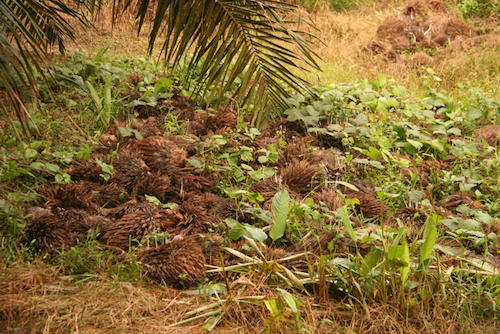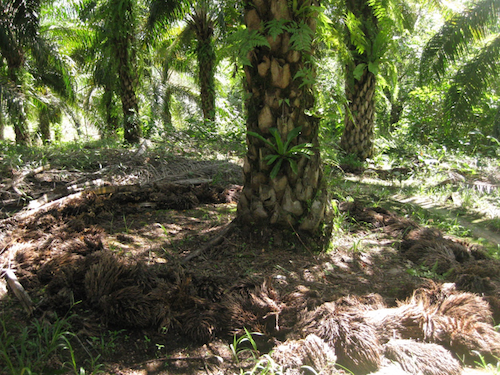Sustainable Oil Palm Farming / Applying empty fruit bunches
| |
Download: Module 4: Fertiliser Application
Contents
Background
Empty fruit bunches (EFB) are what remains of the fresh fruit bunches after the fruit has been removed for oil pressing. Empty fruit bunches are a type of mill waste which is very valuable for farmers because:
- It provides nutrients;
- It increases the soil organic matter content of the soil.
| Empty fruit bunches can replace fertilisers at the following rate: | |
| 1 tonne EFB = | 3.8 kg Urea (N) 3.9 kg Rock Phosphate (P) |
Empty fruit bunches can be bought at the mill, if available. The empty bunches can be transported to the field by the empty trucks that come back to pick up more harvested fresh fruit bunches.
Goal
- To provide the oil palms with nutrients;
- To reduce fertiliser costs;
- To increase organic matter content in the soil.
Standard
- Empty fruit bunches are applied at least once in every 5—8 years.
- Empty fruit bunches are applied in the right way and the right place.
Timing
Whenever empty fruit bunches become available.
Frequency
Every 5 years, if enough empty fruit bunches are available.
Labour time required
- Transport: depends on distance to the mill.
- Application: 2—3 days per hectare.
Equipment and materials
- Wheelbarrow
- Shovel
- Truck (returning empty from the mill)
Note: Empty fruit bunches can be purchased at the mill if they are not all bought up by large plantations. Availability may depend on the smallholder’s relation with the mill and/or competition with other buyers (large companies often get priority). It helps to purchase empty fruit bunches as a cooperative or farmers’ group.
Dosage
- Optimum rate: 30 to 40 t/ha.
- When EFB are applied at the optimum rate there it is enough to replace mineral K, P, Mg and B fertilisers for one year.
- It is recommended to keep applying N fertilisers, because the N in the EFB is mostly not available to the palm.
- Note: 25 tonne FFB produces 5 tonne EFB, so the amount of available EFB is limited 2.
Who
- Transport: Workers who normally transport the fresh fruit bunches to the mill.
- Application: Farmers and their families or hired labourers.
How
Apply empty fruit bunches as fertiliser by following these steps:
| Step 1. | Once the truck has delivered the empty fruit bunches to the roadside, transport the empty fruit bunches into the plantation by wheelbarrow. |
| Step 2. | Apply the empty fruit bunches as follows:
In immature plantations, empty fruit bunches can be applied in the weeded circle. In mature plantations, empty fruit bunches should not be applied in or around the weeded circle, because this will make access into the plantation and collection of the loose fruits more difficult (see Module 5: Pests and Diseases). |
| Step 3. | Check patches of empty fruit bunches regularly to see if there are any breeding rhinoceros beetles. This can be done by turning the empty fruit bunches upside down. Remove any rhinoceros beetle larvae that are found in, or under, the bunches and spread the bunches more widely if necessary. See Module 5, Pests and Diseases for more information about rhinoceros beetles. |
Data recording
Every fertiliser application should be recorded in a logbook as shown in the example below.
| Date | Time | Location | Activity | Input type | Input amount | Input costs | Labour input | Labour costs | |
| People | Hours | ||||||||
| 16/01/13 | Field 3 | EFB application | EFB | 40 tonne | 3000000 | 6 | 8 | 480000 | |
References
- ↑ A. Mannan, 2014, Empty Fruit Bunches (EFB), http://www.etawau.com/OilPalm/EFB.htm, Accessed November 20 2014.
- ↑ I.R. Rankine, T.H. Fairhurst, Field Handbook: Oil Palm Series, Volume 3 – Mature, second ed., Potash & Phosphate Institute (PPI), Singapore, 1999.
Acknowledgements
The material from Applying empty fruit bunches is sourced from Smallholder Oil Palm Handbook and put together by Lotte Suzanne Woittiez (Wageningen Universit) and Haryono Sadikin, Sri Turhina, Hidayat Dani, Tri Purba Dukan, and Hans Smit (SNV) in August 2016. See Module 4: Fertiliser Application for more information.





